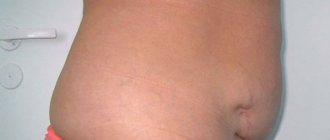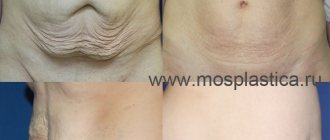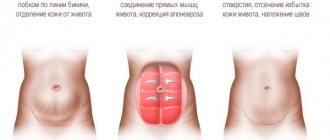The joy of motherhood is a priceless gift for every girl. However, it has another side: the body of a young mother is changing... The stomach suffers the most from postpartum changes - a sagging “apron” and stretch marks appear, muscles stretch, and the skin becomes flabby. Of course, every girl wants to return everything as quickly as possible to the way it was before giving birth. But many are stopped by the questions: “is it possible to give birth after abdominoplasty” and “how will childbirth affect the result of a tummy tuck”? We answer these questions and also tell you when it is better to have surgery in order to get a stable result for years.
Pregnancy after abdominoplasty
So, the main question for girls who dream of a flat and toned tummy is “is it possible to get pregnant in the future after abdominoplasty?” The firm answer from plastic surgeons is “yes”! Let's look at how a tummy tuck works.
The purpose of the operation is to restore the aesthetic proportions of the abdomen. That is: eliminate the overhang of the skin-fat “apron” and loose skin, remove fat deposits, and also close diastasis (separation of the rectus abdominis muscles) and hernia that could occur after the birth of the child. The surgeon makes a horizontal incision in the bikini area (slightly above the pubis), separates the skin and fatty tissue from the muscle, stretches it and removes excess. After this, a suture is placed on the surgical wound. It should be noted that in modern tummy tuck, “gluing” technology is used, when a special skin glue is applied to the seam.
Thus, the surgeon works with the skin, fatty tissue, muscles and fascia. At the same time, internal organs, as well as organs of the reproductive system, are not affected. Therefore, abdominoplasty cannot be a contraindication to conceiving a child or pregnancy. Carrying a baby is the same for both a girl who has had a tummy tuck and one who has not gone to a plastic surgeon. The performed operation does not affect the expectant mother and fetus.
Body
TYPES OF LIPOSUCTION
● Ultrasonic liposuction. Ultrasonic liposuction can be considered in two aspects - as a cosmetic procedure and as a surgical operation.
In the first case, fat destroyed by ultrasound is removed from the body naturally. In the second case, it is sucked out using vacuum suction. fat cells are “softened” using ultrasound. The main advantage of the technique is that the procedure is more comfortable for the surgeon, because physical costs during surgery are reduced. The disadvantages of the technique should also be noted: tissue dehydration, the risk of external and internal burns. ● Laser liposuction. This type of liposuction is aimed at destroying fat cells under the influence of a laser beam. Unlike ultrasound liposuction, laser liposuction has one undeniable advantage - “targeting precision”, which allows you to destroy exclusively fat cells and not damage healthy blood vessels. A microscopic cannula, which removes fat, also reduces tissue trauma. Laser liposuction has a lifting effect; after surgery, patients note an increase in skin firmness and elasticity. Among the obvious disadvantages of the technique is the inability to correct large problem areas.
● Water jet liposuction. The destruction of adipose tissue during water-jet liposuction is carried out using a special solution, which is injected under high pressure into the subcutaneous layers. The surgeon sets the injection force and angle of inclination himself. In this way, the adipose tissue is separated from the connective tissue in the most gentle way. Since no mechanical damage to cells occurs during the operation, the severity of bruises during the rehabilitation period is minimal. Typically used to harvest adipose tissue during lipofilling. The procedure alone does not have any additional effect and can be considered as an option for traditional vacuum liposuction.
● Radiofrequency liposuction. RF liposuction (radiofrequency liposuction) is considered to be the most advanced type of liposuction, thanks to which it is possible not only to eliminate excess subcutaneous fat, but also to tighten the skin and eliminate cellulite. The impact on fat cells occurs using RF radiation; it “melts” fat without damaging blood vessels and nerves. Radiofrequency liposuction can remove large amounts of fat. There is no risk that the skin will sag after the operation, since during liposuction the skin is also tightened. The morbidity of radiofrequency liposuction is extremely low, so the rehabilitation period is much easier and faster.
Possible complications from tummy tuck
Although pregnancy is possible after a tummy tuck, there are some things to consider:
- Abdominoplasty is an operation, which means the body needs to recover after surgery. Especially if we are talking about bearing a child, when the body requires a resource for a good pregnancy;
- natural processes during pregnancy: stretching of the skin, the appearance of stretch marks (stretch marks) and other aesthetic defects on the skin - can change the result of plastic surgery not for the better;
- if the delivery is by cesarean section, then another one will be added to the scar in the bikini area (after tummy tuck).
Progress of the operation
Mini abdominoplasty is a fairly serious surgical procedure, so the operation is performed only under general anesthesia. The average duration of correction is 2 hours.
- Before a tummy tuck, during the examination, the plastic surgeon marks the abdomen where the incisions will be made. This is necessary so that the doctor determines the exact amount of work and makes symmetrical incisions during mini-abdominoplasty.
- The anesthesiologist administers anesthesia to the patient, and the operation area is treated with an antiseptic.
- The plastic surgeon makes incisions in the skin, after which he repairs the umbilical hernia or sutures the muscles of the abdominal wall.
- If the patient is indicated for liposuction, the doctor begins to remove excess fatty tissue in the abdominal area using a long cannula.
- After liposuction, the surgeon removes the skin and fat pad in the lower abdomen.
- The soft tissue and skin are tightened, after which the wound is stitched.
- At the end of the procedure, the wound is treated with an antiseptic and sterile dressings are applied.
A prerequisite after surgery is to wear compression garments, which are placed on the stomach immediately after completion of mini-abdominoplasty.
Why is it not recommended to have abdominoplasty if you are planning a pregnancy?
There are a number of contraindications to tummy tuck:
- acute and chronic heart and kidney failure;
- chronic diseases in the active stage;
- diabetes;
- oncological diseases.
Relative contraindications include planning pregnancy in the near future. Apparently, based on this, myths have arisen that abdominoplasty performed before pregnancy can negatively affect the further bearing of the child or complicate childbirth. But this is not true!
The main reason why abdominoplasty is not recommended before childbirth is that the operation is not practical!
After carrying a baby and giving birth, the abdominal muscles stretch again, the skin loses its elasticity, and the effect of the operation, which consists of tightening those same abdominal muscles, disappears. Yes, there is a high probability that the appearance of the abdomen after childbirth may not only return to its previous state, but also become even worse than before the operation. And then you will have to repeat the plastic surgery.
Does this mean that abdominoplasty is contraindicated before childbirth?
Not at all! Of course, the bulk of a plastic surgeon’s patients are women after childbirth who want to restore their pre-pregnancy shape. But, it is important to understand that a tummy tuck is not always performed for aesthetic purposes. It is also carried out for medical reasons. For example, in the presence of significant diastasis - divergence of the rectus abdominis muscles in different directions, or a hernia.
Of course, it is better if abdominoplasty takes place after childbirth. This is the key to stable results for life. But surgery performed before pregnancy will in no way harm either the mother or the child or interfere with the proper growth and development of the baby.
Repeated tummy tuck after childbirth
And the second side of the situation is childbirth after abdominoplasty. In most cases (based on practice, 70%), subsequent births after plastic surgery will lead to deformation of the anterior abdominal wall. The “apron” on the abdomen, loose skin, stretch marks will appear again... And then a repeat abdominoplasty will be needed. Surgical intervention is performed in the same way as before childbirth. By the way, there is an opinion that a tummy tuck can be performed simultaneously during childbirth. Indeed, such a practice exists, but we recommend not to combine these processes.
It is worth noting that in some cases large-scale abdominal deformation does not occur, and then only minor correction is performed.
Before deciding to undergo a tummy tuck, consult with a plastic surgeon and consider the pros and cons.
Rehabilitation after mini abdominoplasty
In the initial rehabilitation period, the patient wears a bandage or compression garments. Recovery time for miniabdominoplasty is short; sometimes the patient is sent home the very next day after surgery. The rehabilitation period is 7-14 days. It is recommended to take a vacation during this time.
It's not just that you need to exert less physical effort. It is necessary to give the body the opportunity to fully activate its recovery resources.
Any operation, including mini-abdominoplasty, is stressful not only for the internal tissues in the area of surgical intervention, but also for general processes in the body: immune, metabolic.
You can, of course, force yourself to go to work. But general weakness and discomfort are clear signals that the body needs to be given the opportunity to recover. A calm lifestyle and a healthy diet during the rehabilitation period after mini-abdominoplasty will give results much faster, and in the future it will pay off handsomely.
By the way, about nutrition. Abdominoplasty does not affect the internal organs of the abdominal area. At the same time, during the recovery period it is worth paying close attention to your diet. It is necessary to exclude salty, spicy, fried foods. For the first two weeks, it is better to eat light food. Anything that complicates the digestion process (fatty meat, legumes) simultaneously causes blood flow to the abdominal cavity, and this is extremely undesirable after mini-abdominoplasty.
Restrictions also apply to physical activity. If you play sports, you will have to take a break for about 2 months. The same applies to any weight lifting.
All scars after miniabdominoplasty finally resolve after about six months.
Of course, external manifestations disappear much earlier, but physiologically the scarring process lasts about 6 months. During this time, you need to come to the doctor several times for a preventive examination.
In Moscow, many plastic surgery clinics perform miniabdominoplasty. To ensure that the operation is carried out at a professional level, carefully choose a medical institution and specialist. You should pay attention to the reputation of the clinic and reviews about it, the experience, work of the doctor in mini-abdominoplasty, his specialization in surgery.
In our clinic in Moscow, miniabdominoplasty is performed regularly by experienced specialists with extensive professional experience. Visit for a free consultation and find out about the possibilities of tummy tuck in your case!
Video
Example of mini abdominoplasty
Cost of mini abdominoplasty
| Name | Price |
| Excision of the abdominal fold due to deformation of its lower part (miniabdominoplasty) category 1 | 120,000 rub. |
| Excision of the abdominal fold due to deformation of its lower part (miniabdominoplasty) category 2 | 140,000 rub. |
| Primary appointment (examination, consultation) with a plastic surgeon | FOR FREE |









